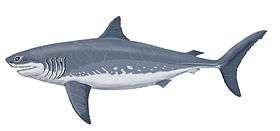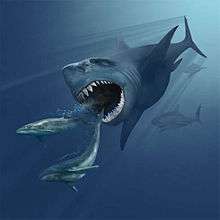Lamniformes
| Lamniformes Temporal range: Early Cretaceous–Recent[1] | |
|---|---|
 | |
| Great white shark, Carcharodon carcharias | |
| Scientific classification | |
| Kingdom: | Animalia |
| Phylum: | Chordata |
| Class: | Chondrichthyes |
| Subclass: | Elasmobranchii |
| Superorder: | Selachimorpha |
| Order: | Lamniformes L. S. Berg, 1958 |
| Families | |
|
See Text | |
Lamniformes is an order of sharks commonly known as mackerel sharks (which may also refer specifically to the family Lamnidae). It includes some of the most familiar species of sharks, such as the great white shark, as well as more unusual representatives, such as the goblin shark and the megamouth shark. The name of the order is formed from the Greek word, Lamna ("fish of prey").
Members of the order are distinguished by possessing two dorsal fins, an anal fin, five gill slits, eyes without nictitating membranes, and a mouth extending behind the eyes. Also, unlike other sharks, they maintain a higher body temperature than the surrounding water.[2]
Species
The order Lamniformes includes ten families with twenty-two species, with a total of seven living families and seventeen living species:
Order Lamniformes
- Family Alopiidae Bonaparte, 1838 (Thresher sharks)
- Genus Alopias Rafinesque, 1810
- Alopias pelagicus Nakamura, 1935 (Pelagic thresher)
- Alopias superciliosus R. T. Lowe, 1841 (Bigeye thresher)
- Alopias vulpinus (Bonnaterre, 1788) (Common thresher)
- Alopias sp. Not yet described
- Genus Alopias Rafinesque, 1810
- Family Cetorhinidae Gill, 1862
- Genus Cetorhinus Blainville, 1816
- Cetorhinus maximus (Gunnerus, 1765) (Basking shark)
- Genus Cetorhinus Blainville, 1816
- Family Eoptolamnidae (Extinct)
- Family Lamnidae J. P. Müller and Henle, 1838
- Genus Carcharodon A. Smith, 1838
- Carcharodon carcharias (Linnaeus, 1758) (Great white shark)
- Carcharodon hubbelli †
- Genus Isurus Rafinesque, 1810
- Isurus oxyrinchus Rafinesque, 1810 (Shortfin mako)
- Isurus paucus Guitart-Manday, 1966 (Longfin mako)
- Genus Lamna Cuvier, 1816
- Lamna ditropis Hubbs & Follett, 1947 (Salmon shark)
- Lamna nasus (Bonnaterre, 1788) (Porbeagle)
- Genus Carcharodon A. Smith, 1838
- Family Megachasmidae Taylor, Compagno & Struhsaker, 1983
- Genus Megachasma Taylor, Compagno & Struhsaker, 1983
- Megachasma pelagios Taylor, Compagno & Struhsaker, 1983 (Megamouth shark)
- Genus Megachasma Taylor, Compagno & Struhsaker, 1983
- Family Mitsukurinidae D. S. Jordan, 1898
- Genus Mitsukurina D. S. Jordan, 1898
- Mitsukurina owstoni D. S. Jordan, 1898 (Goblin shark)
- Genus Mitsukurina D. S. Jordan, 1898
- Family Odontaspididae Müller & Henle, 1839
- Genus Carcharias Rafinesque, 1810
- Carcharias taurus Rafinesque, 1810 (Sand tiger shark)
- Genus Odontaspis Agassiz, 1838
- Odontaspis ferox (Risso, 1810) (Smalltooth sand tiger)
- Odontaspis noronhai (Maul, 1955) (Bigeye sand tiger)
- Genus Carcharias Rafinesque, 1810
- Family Pseudocarchariidae Compagno, 1973
- Genus Pseudocarcharias Cadenat, 1963
- Pseudocarcharias kamoharai (Matsubara, 1936) (Crocodile shark)
- Genus Pseudocarcharias Cadenat, 1963
- Family Cardabiodontidae (Extinct)
- Genus Cardabiodon Michael Silverson, 1999
- Cardabiodon ricki Michael Silverson, 1999 †
- Genus Cardabiodon Michael Silverson, 1999
- Family Cretoxyrhinidae (Extinct)
- Genus Cretoxyrhina Agassiz, 1843
- Cretoxyrhina mantelli Agassiz, 1843 (Ginsu shark) †
- Family Otodontidae (Extinct)
- Genus Carcharocles
- Carcharocles megalodon (Agassiz, 1843) (Megatooth shark) † (genus disputed)
| Family | Image | Common name | Genera | Species | Description |
|---|---|---|---|---|---|
| Alopiidae |  |
Thresher sharks | 1 | 4[5] | Thresher sharks are large sharks found in temperate and tropical oceans around the world. The common name refers to its distinctive, thresher-like tail or caudal fin which can be as long as the body of the shark itself. |
| Cetorhinidae | |
Basking sharks | 1 | 1 | The basking shark is the second largest living fish, after the whale shark, and the second of three plankton-eating sharks, the other two being the whale shark and megamouth shark. It is a cosmopolitan migratory species, found in all the world's temperate oceans. It is generally a harmless filter feeder with a greatly enlarged mouth, which cruises leisurely over huge distances covering three miles every hour. During each of those hours, it strains about 1.5 million litres of water through more than 5,000 gill rakers for plankton.[6] Basking sharks have long been a commercially important fish, as a source of food, shark fin, animal feed, and shark liver oil. Overexploitation has reduced its populations to the point where some have disappeared and others need protection. |
| Lamnidae |  |
Mackerel sharks | 3 | 5 | Mackerel sharks, also called white sharks, are large, fast-swimming sharks, found in oceans worldwide. They include the great white, the mako, and the porbeagle shark. Mackerel sharks have pointed snouts, spindle-shaped bodies, and gigantic gill openings. The first dorsal fin is large, high, stiff and angular or somewhat rounded. The second dorsal and anal fins are minute. The caudal peduncle has a couple or less distinct keels. The teeth are gigantic. The fifth gill opening is in front of the pectoral fin and spiracles are sometimes absent. They are heavily built sharks, sometimes weighing nearly twice as much as sharks of comparable length from other families. Many in the family are among the fastest-swimming fish. |
| Megachasmidae |  |
Megamouth sharks | 1 | 1 | The megamouth shark is an extremely rare species of deepwater shark, and the smallest of the three filter-feeding sharks. Since its discovery in 1976, only a few megamouth sharks have been seen, with 55 specimens known to have been caught or sighted as of 2012, including three recordings on film. Like the basking shark and whale shark, it is a filter feeder, and swims with its enormous mouth wide open, filtering water for plankton and jellyfish. It is distinctive for its large head with rubbery lips. It is so unlike any other type of shark that it is classified in its own family, though it has been suggested that it may belong in the family Cetorhinidae of which the basking shark is currently the sole member. |
| Mitsukurinidae |  |
Goblin sharks | 1 | 1 | Goblin sharks have a distinctive long, trowel-shaped, beak-like snout, much longer than those of other sharks. The snout contains sensory organs to detect the electrical signals given off by the shark's prey.[7] They also possess long, protrusible jaws.[8] When the jaws are retracted, the shark resembles a grey nurse shark with an unusually long nose. Goblin sharks include one living genus and three extinct genera.[9] There is only known living species, Mitsukurina owstoni. |
| Odontaspididae |  |
Sand sharks | 2 | 4 | Sand sharks are so-called because they inhabit sandy shorelines, and are often seen trolling the ocean floor in the surf zone. They are found in warm or temperate waters throughout the world's oceans, except the eastern Pacific.[10] Sand sharks have a large second dorsal fin. They grow up to 10 feet in adult length.[11] The body tends to be brown in color with dark markings in the upper half. These markings disappear as they mature. Their needle-like teeth are highly adapted for impaling fish, their main prey. Their teeth are long, narrow, and very sharp with smooth edges, with one and on occasion two smaller cusplets on either side.[12] |
| Pseudocarchariidae |  |
Crocodile sharks | 1 | 1 | There is only one species in the crocodile shark family. It is a specialized inhabitant of the mesopelagic zone, found worldwide in tropical waters from the surface to a depth of 590 m (1,940 ft). It performs a diel vertical migration, staying below a depth of 200 m (660 ft) during the day and ascending into shallower water at night to feed. Typically measuring only 1 m (3.3 ft) in length, the crocodile shark is the smallest living mackerel shark. It can be distinguished by its elongated cigar-shaped body, extremely large eyes, and relatively small fins. Substantial numbers are caught as bycatch, leading it to be assessed as Near Threatened by the International Union for Conservation of Nature (IUCN). |
| †Cardabiodontidae | †Cardabiodontidae | 1 | 1 | Extinct. Cardabiodontidae includes Cardabiodon, a genus from the Cretaceous, which had existed in Australia, Canada, and Europe.[13] The only species it contained was Cardabiodon ricki.[13] | |
| †Cretoxyrhinidae |  |
†Cretoxyrhinidae | 7 | 15 | Extinct. Cretoxyrhinidae includes Cretoxyrhina (pictured), a genus from the Cretaceous, and Palaeocarcharodon, a possible ancestor of the great white and megalodon.[14] |
| †Otodontidae |  |
†Otodontidae | 3 | 27 | Extinct. Otodontidae lived from the Paleocene to the Pliocene, and reached huge sizes. There is a disputed possibility that the Carcharocles sharks derived from Otodus, which would mean that Cretolamna would belong in this group. There is also a disputed possibility that megalodon (pictured), the largest shark ever, belongs to the group.[15] |
Sustainable consumption
In 2010, Greenpeace International added the shortfin mako shark (Isurus oxyrinchus) to its seafood red list. "The Greenpeace International seafood red list is a list of fish that are commonly sold in supermarkets around the world, and which have a very high risk of being sourced from unsustainable fisheries."[16]
References
- ↑ Froese, Rainer, and Daniel Pauly, eds. (2009). "Lamniformes" in FishBase. January 2009 version.
- ↑ Martin, R. Aidan (April 1992). "Fire in the Belly of the Beast". ReefQuest Centre for Shark Research.
- ↑ http://journals.plos.org/plosone/article?id=10.1371/journal.pone.0127162
- ↑ http://www.livescience.com/51072-giant-cretaceous-shark-uncovered.html
- ↑ Froese, Rainer, and Daniel Pauly, eds. (2013). "Alopiidae" in FishBase. October 2013 version.
- ↑ Basking shark BBC Nature, 13 March 2013. Retrieved 28 March 2013.
- ↑ Stevens, J. & Last, P.R. (1998). Paxton, J.R. & Eschmeyer, W.N., ed. Encyclopedia of Fishes. San Diego: Academic Press. p. 63. ISBN 0-12-547665-5.
- ↑ Froese, Rainer and Pauly, Daniel, eds. (2005). "Mitsukurina owstoni" in FishBase. 10 2005 version.
- ↑ Mikko's Phylogeny Archive
- ↑ National Geographic. "Sand Tiger Sharks". National Geographic. Retrieved 8 December 2012.
- ↑ Froese, Rainer, and Daniel Pauly, eds. (2009). "Odontaspididae" in FishBase. January 2009 version.
- ↑ Bigelow, Henry B.; Schroeder, William C. (1953). Fishes of the Gulf of Maine. United States Government Printing Office. Retrieved 30 October 2011.
- 1 2 Todd D. Cook, Mark V. H. Wilson & Michael G. Newbrey (2010). "The first record of the large Cretaceous lamniform shark, Cardabiodon ricki, from North America and a new empirical test for its presumed antitropical distribution". Journal of Vertebrate Paleontology 30 (3): 643–649. doi:10.1080/02724631003758052.
- ↑ Mikko's Phylogeny Archive
- ↑ Joseph S. Nelson (2006). "Order Lamniformes". Fishes of the World (4th ed.). John Wiley and Sons. pp. 57–60. ISBN 978-0-471-25031-9.
- ↑ Greenpeace International Seafood Red list
Further reading
- Compagno, Leonard (2002) Sharks of the World: Bullhead, mackerel and carpet sharks Volume 2, FAO Species Catalogue, Rome. ISBN 92-5-104543-7.
- Joseph S. Nelson (2006). "Order Lamniformes". Fishes of the World (4th ed.). John Wiley and Sons. pp. 57–60. ISBN 978-0-471-25031-9.
External links
| Wikispecies has information related to: Lamniformes |
| ||||||||||||||||||||
| ||||||||||||||||||||||||||||||||||||||||||||||||||||||||||||